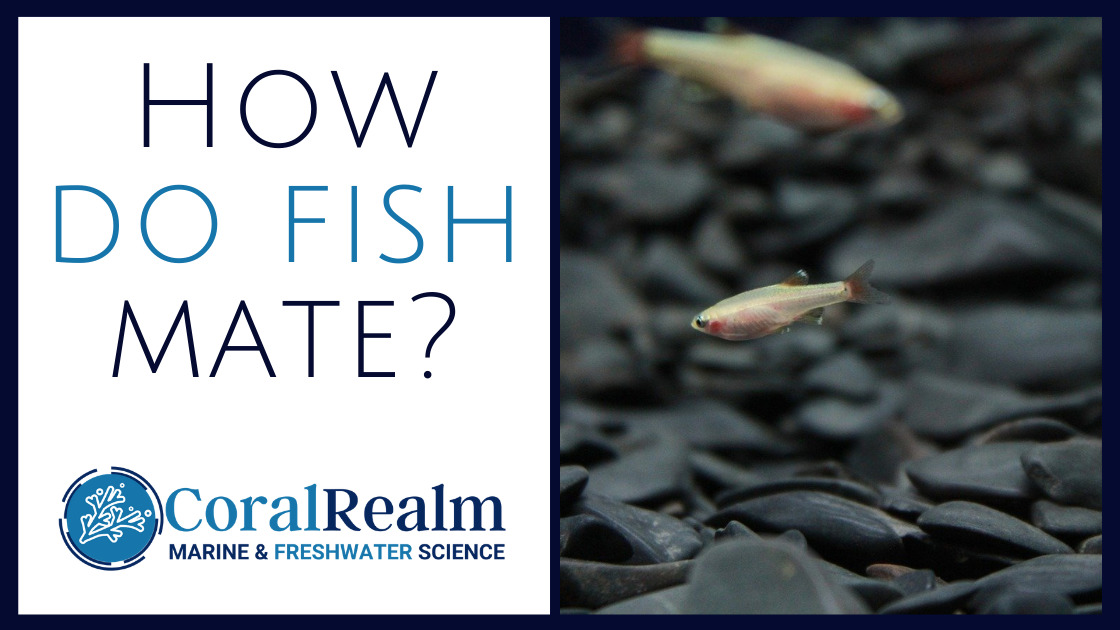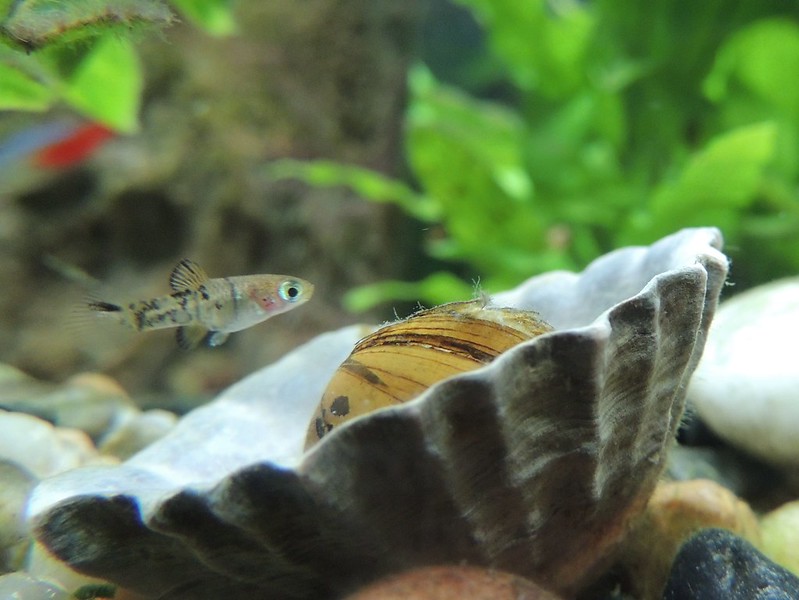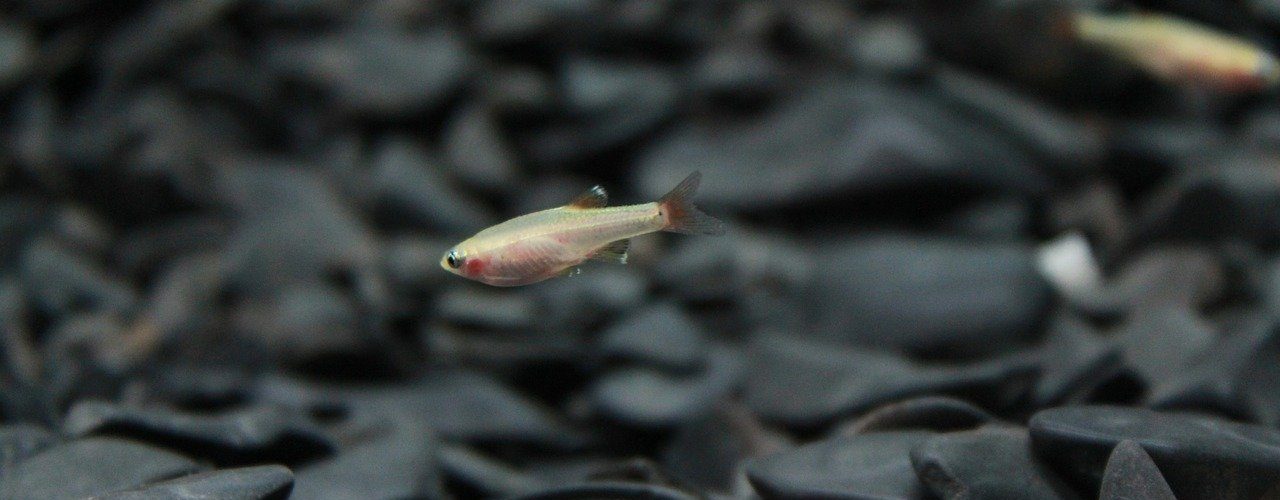Last Updated on November 19, 2022 by Matt
The study and ongoing research in the field of how do fish mate and reproduce has been the result of decades of study by marine biologists. The truth is, nearly all fish species that are currently documented reproduce by standard sexual reproduction – that is sperm and egg mixing – sperm from fish testes, and eggs from fish ovaries.
Question: How do fish mate? Answer: Most fish have distinct sexes, and mate by a male’s sperm fertilizing eggs from a female. That is true for a Betta Fish in an aquarium or sharks off the coast of Australia. Fish mating can be classified in three ways, Oviparity reproduction, Ovoviviparity reproduction and Viviparity reproduction. CoralRealm.com
Reproduction therefore is different depending upon the species of fish in question. Fish actually copulate in several different ways too. In the vast majority of cases, the female fish will spread her eggs into open water. This act of dropping the eggs is common. The male then releases sperm into the same body of water and this immediately fertilizes the eggs.
The second way is for this process to take place within the female prior to dropping the eggs in the water. The process is exactly the same, but fertilization of the eggs simply took place within the female.

In the final method, the female keeps eggs within her. These eggs hatch and are born live. However, they were in separate egg casings within the body. These livebearing fish species is common in the … family (I.e. guppies) and in many shark species.
However, there are many species of fish that are hermaphrodites. These fish, not by accident, have both sex organs.
A hermaphrodite species of fish, such as Gobies, will typically produce one gamete (sperm or eggs) at any given time, meaning that they still need a mate, just they have to be fertilized by another member of the same species that is producing the opposite gametes.
Generally, hermaphroditic fish species will take on one sex at a time, alternating between producing eggs, or producing sperm depending on their sex. This temporary state is really just a reproductive cycle, producing either depending on the cycle.
Some species of hermaphroditic fish, such as salmon, that produce both eggs and sperm, however, they still have genders and the male will release sperm, and the female eggs when they travel upstream to fresh water to reproduce.
Finally, there is another unusual method of reproduction in fish. This is only found in a small number of fish species, how do fish mate in this instance? Using a process known as parthenogenesis, in parthenogenesis fish offspring at genetic copies of their mothers. This is achieved because a female egg develops into a new fish without sperm binding. This type of reproduction has been noted in bony fish and some shark species.
IN THIS ARTICLE
Reproductive Fertilization of Fish
In most fish species, fertilization is external. In those instances, the fish release egg and sperm into the water, and the eggs are fertilized in ‘open water’. We would called this frenzied process spawning. This extremely large grouping of fish is a protection and survival instinct. By grouping together in large numbers; the chances of survival and fertilization is higher.
Obviously, the disadvantage of spawning is no control over where the eggs will hatch, no protection for the young, and certainly no parental involvement of any kind.
Some species of fish are known as mouth-breeders, how do fish mate in this instance? Well they brood their eggs in their mouths, usually, this is the male that protects the eggs until hatching in this way. Examples include sea catfish, the jawfish and even the cardinalfish.
How Fish Mate – Classifications
There are five ways we classify the reproductive ways fish mate. These three categories determine how fish mate based on if they give birth to eggs or are live-bearing fish.
- Oviparity Reproduction
- Ovoviviparity Reproduction
- Viviparity Reproduction
- Parthenogenesis Fish
- Hermaphrodite Fish
1. The Oviparous Fish (Egg Laying Fish)
In oviparous fish, like birds and reptiles, offspring will develop inside an egg. The egg contains a yolk; food for a developing embryo. When we study bony fish species, more than 90% of them reproduce in this manner.
While fertilization may differ, the female needs to lay eggs, and then unlike reptiles and birds, sometimes externally the eggs are fertilized by a male.
Female fish tend to lay huge numbers of eggs in one sitting. This is for two reasons:
- The chances of an egg surviving outside the mother is significantly lower.
- It takes less energy to fuel an egg outside the mother
The fecundity of a fish is a term used to describe how many eggs the mother can lay. The factors included here are correlated to the habitat, size, weight and chances of survival of the eggs.
In the wild, there are some extreme examples of high fecundity fish. One such fish is the Ocean SunFish, which releases between 100 and 350 million eggs in any giving spawning season.
Oviparous Fish come in a variety of forms, some of you may even be familiar with these. There are the Mouth-brooding Fish. This eggs are often carried by the male of the species. These fish are laid in water, but then held and cared for in the mouth. These are often deepwater catfish, Cardinal fish and freshwater Cichlids.
There are also nest building Fish. These can be made from materials, or a bubble nest. Perhaps the most famous example of the latter is the Male Betta fish, who carefully constructs a bubble nest to place the eggs in. Some fish, like the kuhli loach, will lay their eggs in floating plants. Others will lay their leaf shaped eggs on rocks, such as the Ribbon Eel, a fish notoriously hard to keep in captivity.
We also have the open water eggs layers These fish lay their eggs in open waters. This could be salmon, the ocean sunfish we mentioned above, or even goldfish. Whether they are hidden or not, these fish don’t do anything fancy for the eggs. The males release sperm over the eggs to fertilize them, and it’s that simple.
The forth category are fish who bury eggs. This process is hard in a captivity setting, usually down to an unsuitable substrate. Fish such as the Killifish will often do this, the male will then have to get into the substrate in order to fertilize the eggs.
As a final example of the major differences in egg laying fish, during spawning a female Dwarf Lionfish produces gelatinous masses that resemble frogsspawn, containing thousands and thousands of eggs. Such eggs will hatch within 2 days.
2. Ovoviviparous and Viviparous Species (Livebearing Fish)
Ovoviviparous and Viviparous Species of fish are what we call livebearing fish. That means these fish give birth to live fry. These fish are incredibly small, vulnerable and often sometimes eaten by their own mothers.
Example of a Livebearer is the Guppy. Guppies are a species of well known livebearing fish. The gestation period for this common tank fish, is approximately 25 days.
Males are relentless in this, and reproduction continues through the whole year. Thee female guppy is ready for conception again quickly after parturition, like all the Poeciliidae family.
In live-bearing fish,a male and female fish mate, the fertilization takes place inside the mother and the mother then gives brith to a large group of fry.
The male possesses a modified tubular anal fin, called the gonopodium fin (see photo below) and sperm is released from the fin into the female to fertilize the eggs. In Ovoviviparous species, the egg inside the mothers body provides all the nutrition, when they are grown, they are released. In viviparous species, the fry develop inside the mothers body, taking nourishment directly from the mother than a yolk. It’s not known exactly, but it’s thought the latter has a greater chance of survival.
3. Parthenogenesis Fish
In our introduction, we talked about a process called parthenogenesis. In these fish species, the females create a genetic clone of themselves. Therefore, all the offspring are also female.
These fish are highly unusual. Sexual reproduction typically needs two ingredients: a single egg cell and a single sperm cell. Each cell provides half of the genetic information needed to create life. However, in parthenogenesis, the cells find a crazy way of filling in for missing genes; missing genes normally provided by the sperm cell.
4. Hermaphrodite fish
Hermaphrodite fish are another interesting phenomena within fish, these fish, possess both male and female reproductive organs.
They come in two forms, for example, a fish that can change sex (either from male to female or vice versa) or, a fish that is both simultaneously male and female. A fish that is both simultaneously male and female does not require a mate.
One species of fish that can ‘mate with itself’ is the Mangrove Killifish. It produces both eggs and sperm and so it simultaneously male and female. We call this process synchronous hermaphroditism
Clownfish are the most well known species of hermaphrodite fish. Male Clownfish are capable of turning into female Clownfish within a group. We call this process of male to female: protandrous hermaphrodites. If it’s the other way around, it’s referred to as protogynous hermaphrodite.
Clownfish still need a member of the opposite sex to breed, since their organs change.
When do fish develop reproductive organs?
This is a broad question – and we’re unable to answer this specifically because each fish species is different.
Generally, the smaller the fish the faster they will begin to breed. This is in part due to a short lifespan of small fish.
Reproductive organs in fish typically develop the slowest in livcebearering gestation, because an early birth without reproductive organs would not signal death in the fish.
Some fish, like the and sharks, can take years to reach sexual maturity prior to reproducing. This is why protecting our oceans is vitally important.
How do fish mate in an aquarium setting?
Breeding fish in an aquarium can be easy or hard depending on the species. For example, if you want to breed guppies, the process is incredibly easy. In fact, breeding guppy fish is so easy that often you don’t require any preparation outside of literally buying a pair of guppies.
If you’ve got a pair of betta fish, breeding would require much more attention. And breeding Pearl Gourami’s would be even harder.
The point is, how do fish mate in an aquarium setting depends entirely upon the species you have, and secondly upon the environment you place them in.
From nest building, to live-bearing fish, you will come across a remarkable and wide range of fish mating within the tank.
How often do Fish Mate and Reproduce?
Again, this question cannot be directly answered. However, most aquarium fish species will attempt to mate at least once per year. Smaller fish, like guppies are capable of live bearing many times per year. But generally speaking, as an average this is a once per year activity.
Livebearers like Mollies, Guppies, Swordtails, Platys (all part of the Poeciliidae species) are going to breed and reproduce many times per annum.
However, we all know the story of the Salmon. Salmon migrate 100s of miles back to the breeding groups they were born in. Upon reproducing, these fish will die and become food for Grizzly bears. As such, these fish only reproduce once in their lifetime.
And then there is everything in between, therefore, it is hard to generally tackle the question how often do fish mate and reproduce.
Mating Rituals of fish:
Fish have several different kinds of mating rituals depending on the species. However, they all share similarities.
First of all, in the wild, fish only mate when there is adequate food source, and a healthy, normal ratio of males to females. Normally, both of these things are always met. Nature has a way of controlling this anyway.
Some species of fish have the male and female roles reversed. In pipefish and seahorses for example, the male carries the babies.
Once those basic conditions are met, the fish will court each other. In many species this involves swimming in circles around the female. And then finally swimming in parallel until the male uses a specialized anal fin to fertilize the female.
In other fish, this process is much less elegant. In Guppies for example, the male makes no attempt to court the female, and the prize goes to the most persistent and strongest male who simultaneously fights off other males, and swims after the female. Often only being able to fertilize after she reaches near exhaustion. Whereas the Crowntail Betta Fish makes much more of an attempt to court a female prior to building a bubble nest.
This is one reason why some female guppies can be killed by male guppies if the ration of male to female is not optimal.

(CC BY-SA 2.0) by Upupa4me
So you want to breed fish?
If you want to breed fish at home. You first need to:
- Choose the right species.
- Identify the sex of the fish
- Set up the tank conditions.
Let’s break these areas down below, and go into more detail about what we mean here.
1. Choose the right species of fish to mate
Choosing the right species to breed isn’t easy. Most people find livebearing fish are much easier to keep, much easier to encourage to breed; and the fry have a greater chance of survival. Egg layers, on the other hand, are more dedicate fish in general, and more delicate in what conditions they require in the tank.
Often livebearing fish are place into a isolation chamber when breeding. This way the live fry drop into a small space separate from their mother. The mother will often eat her own fry – and it isn’t quite sure why this is.
Our scientists at CoralRealm believe this act of eating your own young is a survival instinct, Chris says:
“It seems unusual to say that it’s instinct for a mother to eat her own. But given the volume of a live fry birth, we think removing some of them gives the others the greatest chance of finding food and generally keeping the population in a safe level. Unfortunately instinct hasn’t caught up with evolution and the fact that many of these fish now have a rich food source, be it in the wild or in captivity.
Nevertheless, breeding live fry birthing fish is significantly easier than egg layers. We suggest start with them, then move onto hardy egg layers, and then onto more complicated nest building fish.
2. Identify the right sex of mating fish
Identifying the sex of fish is not always easy, fish are either sexually dimorphic or Sexually isomorphic; meaning that some are visibly easy to differentiate and other species are hard to identify.
The reason we want to identify male and females vs buying a large group is that getting the ration of females to males just slightly wrong can throw off the desire to mate.
For example, your generally want one male fish to every 5 females.
Having a non-optimal ratio will prevent the fish breeding. Often males will fight, and the females will be tormented by multiple males.
This is also unethical. In the wild, these fish naturally control the numbers of males and females together. With a closed glass space – it’s important you uphold that natural ratio.
3. Set up the tank to fit the needs of fish reproduction
To successfully mate fish in an aquarium. You first have to identify the right sex, choose a species that is easy enough to breed, and finally you can set up the right tank conditions.
Obviously all species are different, but our answer in thinking about how do fish mate in the aquarium is universal. I.e. these things must be met no matter the species.
There are 5 main things to think about:
- Tank size
Generally, fish will breed when the space they are in exceeds their minimum requirements.
- Tank nature (plants, rocks etc)
Fish will rarely breed in low oxygenated water, poor water quality or a perceived lack of food. Lack of plants creates all 3 situations. Fish instinct does not work on food, but on foliage. If there is an abundance of foliage – there is an abundance of food. You will have a hard time mating fish if there are no plants.
- What tank mates are present
Breeding fish in a community tank can be done. But most fish require privacy from other fish. Other fish increase stress hormone levels that reduce the chances of a fish finding a mate. When we sought out to answer how do fish mate in the aquarium – this is one of the most overlooked pieces of information.
Additionally, if you are able to get fish to mate in a community tank, good luck on raising the fry. They are likely to be eaten by almost every other species.
I have yet to see a species of fish not eat fry, however, in my community tank the clownfish tend to leave the guppy fry alone. In fact, it is the guppies themselves that are their own worse enemy.
For the best chance of success, keep a single species tank.
- Water conditions (temp, pH etc)
Generally, fish will only mate when their specific water criteria conditions are met. This means temperature, pH and water hardness values. While you can breed fish outside normal parameters, the more sensitive young are unlikely to survive. Reduce aquarium phosphate, reduce toxic nitrates, and keep ammonia levels low.
In addition, water water may increase the chances of mating in some species.
- Separation of males and females.
Our private research shows that you can tap into a ‘panic instinct’ in fish. Our marine biologist says:
Separating males from females can force a panic instinct to breed when they are suddenly put back together. This absence leads to urgency, and some fish keepers will find this a useful tactic when encouraging fish to breed. In the study of how fish mate, this is an incredibly interesting finding
– Chris, Marine Biologist at CoralRealm
Takeaways | A summary in the study of how fish mate:
- Virtually all fish species will reproduce by standard sexual reproduction. That is to say, the combining of a sperm and an egg cell.
- Most species of fish are only one sex. There are males, and there are females. However, some fish are Parthenogenesis fish, while others are hermaphrodites.
- Parthenogenesis fish can produce a clone of themselves, without the need for a mate.
- Hermaphrodites fish can take two forms, either having both testes and ovaries, or changing and morphing sex, still requiring a sex of the opposite.
- Aside from Parthenogenesis fish. Fish need fertilization for reproduction to occur.
- In most fish species, fertilization is external. In those instances, the fish release egg and sperm into the water, and the eggs are fertilized in ‘open water’.
- Some fish give birth to live fry, others give birth to eggs.
- Egg laying fish are Oviparous.
- Live birthing fish are Ovoviviparous or viviparous.
- Captive and wild fish breeding behavior is different.
- Fish breeding rituals vary wildly by species.
- Separating males from females can force a panic instinct to breed when they are suddenly put back together.




